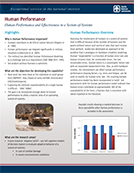
Human Performance and Effectiveness in a System-of-Systems
Assessing the involvement of humans in a system-of-systems (SoS) is difficult because of the number of humans and the poorly defined nature and variety of tasks that each human must perform. Sandia has developed an approach to the problem that is analogous to hardware reliability modeling. In this approach, tasks are generalized. Human “inoperability” is a function of human error rate and human recovery time, for recoverable errors. For non-recoverable errors, human failure is a function of catastrophic failure rate with an associated replacement time. Also, as with hardware systems, the environment can affect human performance; performance-shaping factors, such as stress and fatigue, can be used to modify the human error rate. The resulting human performance model has been incorporated in the System of Systems Analysis Toolset (SoSAT). SoS assessments with the human performance model indicate that human errors contribute to approximately 30% of the unavailability of the force, a fraction that is consistent with values reported in literature.
Why is Human Performance important?
- Humans contribute to 20-53% of system failures (Shapiro et al. 1960)
- Human performance can degrade significantly in military situations (Lieberman et al. 2005)
- The military has identified Human Performance Modeling as a challenge and as a requirement (DoD 5000.59-P, 1995)
- SoS analysis without humans is optimistic
What are the objectives of developing this capability?
- Capture the inherent unpredictability of a large population of human participants
- Incorporate enough detail in human performance to allow a realistic view of an operating system-of-systems
What are the research areas?
- Future research: Adaptive SoSAT-using full cognitive models of decision makers to evaluate adaptive behavior of a system-of-systems:
- In case of combat damage
- In severe environmental conditions
Fact Sheet

Click Fact Sheet to download PDF.